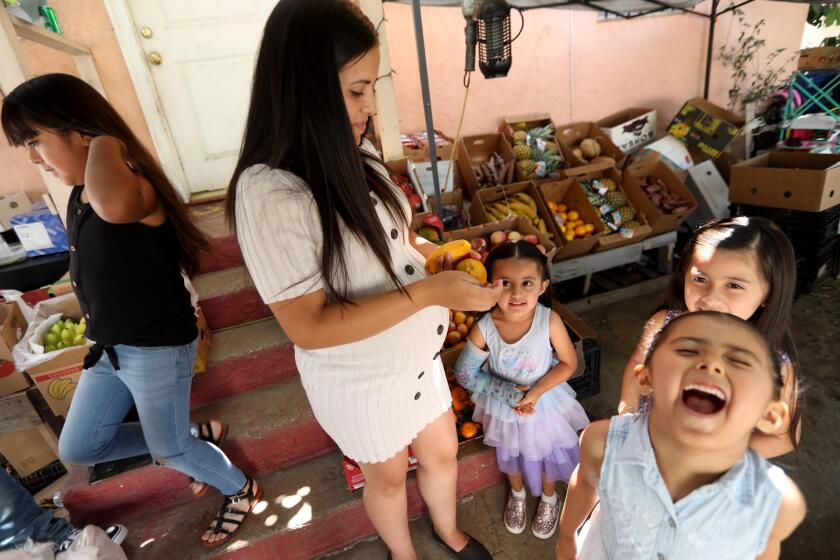California unveiled a blueprint for the future of early education. Critics say it’s built on shaky ground

- Share via
After months of delays and pandemic upheaval, California officials on Tuesday released the long-awaited Master Plan for Early Learning and Care, a 113-page blueprint to remodel the state’s Byzantine child-care system and dramatically expand public preschool.
“The Master Plan shows how one state can achieve goals that are soon to become national ones,” the authors noted. “California can use the Master Plan to signal its fitness as an early partner with the incoming Biden administration,” which advocates early-education reform and better access to child care.
But critics say the forward-looking document does little to shore up the existing infrastructure, even as it crumbles underfoot. Unlike K-12 schools, preschools and day-care centers have been allowed to operate throughout the pandemic. Yet since March, almost 400 child-care centers have closed permanently, and at least 5,700 licensed family child-care homes have gone under, leaving tens of thousands of working parents in the lurch.
It’s hard to predict what may happen when California’s primary schools reopen. But when it comes to the state’s youngest students, data are more robust and reassuring.
“We’re sounding the alarm, because the system is on the verge of collapse,” said Max Arias, chairman of the Child Care Providers Union, which represents thousands of workers. “Who knows how the sector will look when it’s time to start implementing this plan? We need to address this crisis, because if not, there won’t be any child-care providers left.”
Indeed, the pandemic has further destabilized an industry that was already in decline when Gov. Gavin Newsom campaigned on early-education reform in 2018, and when experts began work on the plan last fall. Echoing the Master Plan for Higher Education, the Master Plan for Early Learning and Care was envisioned as a 10-year guidebook for new legislation, investment and reform. Its main goals include uniform standards for early education, better training for child-care workers, easier access to subsidized care for low-income families and universal transitional kindergarten for all California 4-year-olds.
“The goals they lay out are great, but where’s the roadmap for actually getting this done?” asked Ted Lempert, a former state assemblyman who is president of the research and advocacy organization Children Now. “COVID has made this system so fragile and so essential. Now we’re in code red.”
The plan itself acknowledged the crisis, including its impact on working families.
“The COVID-19 crisis has put increased pressure on an already fragile provider ecosystem,” the report said. “Stabilizing and supporting the workforce is critical to the state’s response and recovery process.”
Yet the authors offered few details on how California would help preschools and day-care centers stay open while it sorts out funding for its more ambitious goals. Instead, its most immediate action would be to untangle some of the bureaucracy governing early-childhood care by shifting oversight for virtually all state-subsidized programs from the state’s Department of Education to the Department of Social Services. The plan suggests then streamlining publicly funded programs, simplifying eligibility for low-income families and overhauling reimbursements for providers, which the report called “overly complex and inequitable.”
“There is a racial wage gap in our state that was not addressed in the plan,” said Ashley Williams, a senior policy analyst at the Center for the Study of Child Care Employment. “Early educators are [up to] 14 times more likely to be earning poverty wages than the K-12 workforce, which is predominantly white. There is an issue of racial inequity happening, especially when we think about compensation.”
As many private preschools prepare to reopen for the school year, many of California’s poorest and neediest children are stuck at home, waiting for public preschools to reopen or offer distance learning, which is far from ideal for a 4-year-old.
The amount the state pays per child in subsidized care varies by county — home day-care providers in L.A. make $30 less per child per day than those in San Francisco, for example — and workers say all of them are low. Yet while the state pays relatively little, it also tightly limits the number of vouchers available, despite what the report called a “dizzying array” of subsidized programs.
“We have thousands of families on what we call an eligibility list,” which is essentially a waiting list for subsidized care, said Sally Valenzuela, who works with providers at Pathways LA, a child-care resource and referral agency. “We see a lot of children stay on that list for years and years and never get access to child care, and then they’re off to kindergarten.”
Preschool, too, is often unattainable. Currently, just one in three eligible children can find a spot in public programs. Almost a third of those left out every year live in L.A. County — more in a single ZIP Code in South L.A. than anywhere else in the state.
The Master Plan would extend free public preschool to every qualified 3-year-old in the state and make transitional kindergarten universal for every 4-year-old. But even with federal help, such a dramatic expansion would take years. With reduced capacity and soaring expenses, many providers have dipped into their savings to stay open, and thousands of others have closed.
“They’re looking for some form of hope,” Arias said. “The parents who are relying on them are the parents who have to go to work — a lot of them are healthcare workers. You can just imagine the pressure.”
An October survey showed that 61% of providers would actually expand if they had help from the state. But like everything else in the plan, that help would have a hefty price tag. According to the report, fully funding the Master Plan would cost up to $12 billion a year, though many experts believe it could be much more. State, federal and local governments currently spend about $6 billion a year on California’s early-education and child-care system, while parents pay another $6 billion.
“These great things the plan is talking about need dollars,” Lempert said. “It seems almost out of touch with what families are experiencing today.”
Without more immediate assistance, many fear, California’s existing child-care system could crumble past the point of repair.
“This plan is tied to that pre-pandemic understanding of child care, and the system will never be the same after this,” Williams said. “The foundation has been cracked severely, and we can’t just build new things on top of it.”
More to Read
Sign up for Essential California
The most important California stories and recommendations in your inbox every morning.
You may occasionally receive promotional content from the Los Angeles Times.













